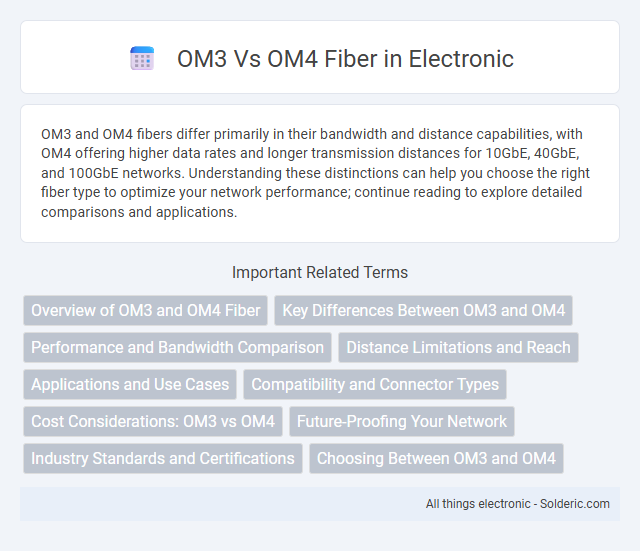OM3 and OM4 fibers differ primarily in their bandwidth and distance capabilities, with OM4 offering higher data rates and longer transmission distances for 10GbE, 40GbE, and 100GbE networks. Understanding these distinctions can help you choose the right fiber type to optimize your network performance; continue reading to explore detailed comparisons and applications.
Comparison Table
| Attribute | OM3 Fiber | OM4 Fiber |
|---|---|---|
| Core Diameter | 50 microns | 50 microns |
| Wavelength | 850 nm, 1300 nm | 850 nm, 1300 nm |
| Bandwidth (@850 nm) | 2000 MHz*km | 4700 MHz*km |
| Maximum Distance (10 GbE) | 300 meters | 550 meters |
| Maximum Distance (40/100 GbE) | 100 meters | 150 meters |
| Color Coding | Aqua | Laser Optimized Aqua |
| Cost | Lower | Higher |
Overview of OM3 and OM4 Fiber
OM3 and OM4 fiber are types of multimode optical fibers designed for high-speed data transmission in data centers and enterprise networks. OM3 fiber supports 10 Gigabit Ethernet up to 300 meters, while OM4 fiber extends this reach to 400 meters, making it ideal for longer distance applications. Choosing the right fiber impacts your network's performance and future-proofing capabilities.
Key Differences Between OM3 and OM4
OM3 and OM4 fiber optic cables primarily differ in their bandwidth and transmission distance capabilities, with OM4 offering higher bandwidth up to 4700 MHz*km compared to OM3's 2000 MHz*km, enabling faster data transfer rates. OM4 supports longer distances for 10 GbE, reaching up to 550 meters, whereas OM3 maxes out around 300 meters, making OM4 ideal for more demanding network environments. Your choice between OM3 and OM4 should align with your network's performance requirements and future scalability plans.
Performance and Bandwidth Comparison
OM4 fiber optic cables deliver significantly higher bandwidth and longer transmission distances compared to OM3, supporting 10 Gigabit Ethernet up to 550 meters and 100 Gigabit Ethernet up to 150 meters. OM3 typically supports 10 Gigabit Ethernet up to 300 meters and is less efficient for higher-speed applications. The improved laser-optimized performance of OM4 results in better modal bandwidth, typically measured as 4700 MHz*km compared to OM3's 2000 MHz*km, making OM4 ideal for data centers requiring enhanced data throughput and future-proofing.
Distance Limitations and Reach
OM3 fiber supports a maximum distance of up to 300 meters for 10 Gigabit Ethernet, while OM4 fiber extends this reach to 400 meters, providing improved performance for high-speed data transmission. Your choice between OM3 and OM4 depends on the required distance limitations for your network infrastructure, with OM4 fiber offering a longer reach and better bandwidth. Both fiber types use laser-optimized multimode technology, but OM4 is optimized for higher bandwidth and longer distance capabilities in modern data centers.
Applications and Use Cases
OM3 fiber supports high-speed 10 Gigabit Ethernet networks up to 300 meters, making it suitable for data centers and enterprise connections requiring reliable moderate distances. OM4 fiber extends this capability by supporting 10 Gigabit Ethernet up to 550 meters and 40/100 Gigabit Ethernet up to 150 meters, ideal for high-performance computing environments and large-scale data centers. Choosing the right fiber impacts Your network's future scalability and performance needs, especially in environments demanding greater bandwidth and longer reach.
Compatibility and Connector Types
OM3 and OM4 fibers share compatibility with standard multimode connectors such as LC, SC, and ST, ensuring seamless integration into existing fiber optic networks. Both fiber types utilize laser-optimized 50-micron core diameters, which support OM3's 10 Gbps and OM4's 40 Gbps and higher data transmission rates over similar distances. Connector types remain consistent across OM3 and OM4, with key considerations centered on performance requirements and network design rather than physical connector differences.
Cost Considerations: OM3 vs OM4
OM3 fiber generally offers lower upfront costs compared to OM4, making it a budget-friendly choice for short to medium-distance applications up to 300 meters at 10Gbps. OM4 fiber supports higher bandwidth and longer distances--up to 400 meters at 10Gbps--justifying its higher price in deployments requiring future-proofing and enhanced network performance. To optimize Your infrastructure investment, consider the balance between immediate budget constraints and long-term scalability needs when choosing between OM3 and OM4 fibers.
Future-Proofing Your Network
OM4 fiber offers higher bandwidth and longer reach compared to OM3, supporting up to 10 Gb/s at 550 meters versus OM3's 300 meters, making it more suitable for future network demands. Choosing OM4 ensures better scalability for high-speed applications such as 40G and 100G Ethernet, helping future-proof your network infrastructure. Investing in OM4 fiber reduces the need for costly upgrades as data rates continue to increase over time.
Industry Standards and Certifications
OM3 and OM4 fiber optic cables both comply with the ANSI/TIA-492AAAC and ISO/IEC 11801 international standards, ensuring reliable multimode fiber performance for high-speed networks. OM4 fibers are certified to support 10 Gigabit Ethernet up to 550 meters and 40/100 Gigabit Ethernet up to 150 meters, outperforming OM3's 300 meters for 10 Gigabit Ethernet. Both types meet strict UL and RoHS certifications, confirming safety, environmental compliance, and suitability for enterprise data center and telecommunications infrastructure.
Choosing Between OM3 and OM4
OM4 fiber offers higher bandwidth and longer transmission distances compared to OM3, making it ideal for future-proofing high-speed networks such as 40G and 100G Ethernet. OM3 supports up to 300 meters at 10 Gbps, whereas OM4 extends this reach to 400 meters, providing better performance in data centers and enterprise environments. Choosing between OM3 and OM4 depends on your network's speed requirements, budget, and the need for scalability in fiber optic infrastructure.
OM3 vs OM4 fiber Infographic

 solderic.com
solderic.com